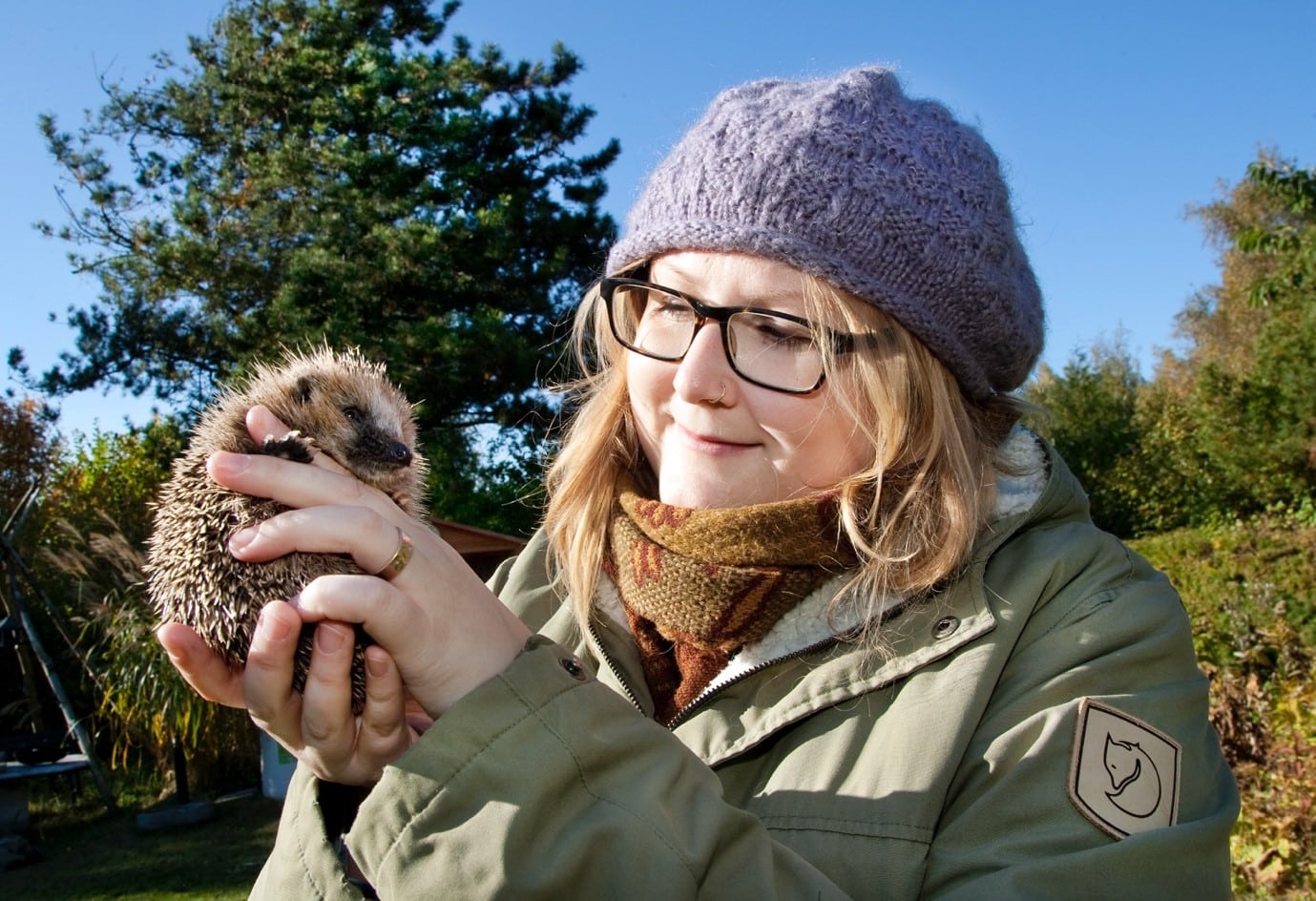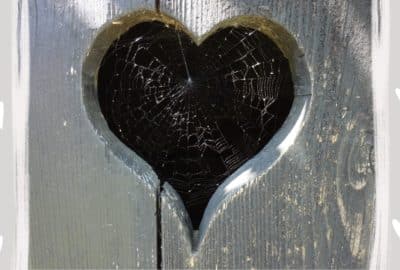How horny are hedgehogs?
Wednesday 19th Feb 2025, 12.30pm
Shh…hedgehog! It always feels like a privilege to catch a glimpse of one, as it snuffles away under the garden fence. And come the spring, our spiny – and usually solitary – little friends will be feeling in the mood for…romance. But what exactly does a female look for in a mate? And how do their intimate encounters even work when things are so very… spiky? Join us for this special Valentine’s Day edition of the Big Questions Podcast, as we ask Dr Sophie Lund Rasmussen (aka Dr Hedgehog) “how horny are hedgehogs?”
Emily Elias: When you’re thinking about sexy animals, hedgehogs might not spring to mind, but… maybe they should. They really put the work in when it comes to getting an intimate encounter. And on this episode of the Oxford Spark’s Big Questions podcast, we are looking at hedgehog sex, and we are asking ‘how horny are hedgehogs?’
Hello, I’m Emily Elias, and this is the show where we seek out the brightest minds at the University of Oxford, and we ask them the big questions. And for this one, we have found a researcher who loves hedgehogs so much they call her Dr Hedgehog.
Sophie Lund Rasmussen: I’m Dr Sophie Lund Rasmussen, or Dr Hedgehog, and I’m a specialist on European hedgehog, so that’s basically what I do. I research the lives, mysterious lives, of the European hedgehogs to understand why they’re declining and what we can do to stop this decline.
Emily: So Sophie this is our season, because last year we spoke to you about when did we start kissing, and this time around, we are talking about how horny hedgehogs are.
You are a researcher of love. Can we dive into the basics of this, because I, as a novice, how do hedgehogs have sex? What is this like?
Sophie: Well, very carefully, I would say, because they’re obviously covered in spines. An adult hedgehog has up to 8,000 spines, so it could be rather painful to mate. So the trick is that whenever the female is ready to mate, she will lower her spines and stretch her legs a bit, allowing the male to mount her and mate. But this is a very complex process, because she’s not very willing to accept his offers of marriage.
Emily: I can understand that – it’s a lot to get the physics of it working together.
Sophie: Definitely, and hedgehogs are solitary creatures. So the rest of the year, they live solitarily, and they don’t stay together, and they don’t really interact. I mean, they accept each other’s presence in the residential gardens where you would normally find them, but they don’t really interact. So it’s only during the mating season that they come into close contact, typically. Sometimes they can also get into fights over a very nice food bowl filled with cat food, for example. But most of the times, they’re just left to themselves, so they really interact during the mating season, and they’re promiscuous. So the males mate with as many females as possible, and the other way around as well.
Emily: OK, so how can you tell if they’re mating and they’re not fighting?
Sophie: Well, the sounds are quite similar, actually, because the females are very hard to get. And they make sort of a hissing sound during this, you could say, courtship behaviour. So it’s like, you can almost hear her saying, “Piss off, piss off.” And the male just keeps circling the female, trying to impress her, trying to get his opportunity to mount her, and she’s constantly turning around, pointing away from him, and hissing at him, telling him to basically, [“Keep his off.”] And this can take hours and hours. She will eventually give up and say, “OK, OK, let’s do this.” And then the mating act itself only takes a very short while, so it’s a lot of effort. And the worst part is that some of my colleagues have actually studied this mating behaviour, and they found that only, like, between four to seven percent of these courtship behaviours actually lead to mating. So they’re not often successful, the males, they really have to impress the females. And the problem is that during this whole courtship display and fighting over mating or not, they might attract other males, because they’re very noisy, you know, they’re hissing at each other. And then when other males show up, the males will start to fight and try to win the favour of the females. So it’s really difficult for the males to actually get to mate.
Emily: You did say they are promiscuous, so, like, as much as they are, like, putting up the pretence, they don’t want it. Like, they want it… Is that the sort of vibe?
Sophie: Yeah, definitely. And I think this is also a strategy to measure the quality and fitness of the male, because if he can really continue to keep up that energised level of running around in circles and trying to impress her, “OK, he must be, you know, in good health, good fitness.” So I think it’s also a way to assess male mate quality, basically, for the females, but they are really hard to get and it’s quite funny to witness this…
Emily: I take it you witnessed this. What was it like?
Sophie: Well, I also once unintentionally interrupted a mating, and that was just such a shame, but I had radio tagged 35 juvenile hedgehogs in the suburbs of Copenhagen to understand which challenges they actually face in the suburbs.
And I followed them around for the first year of their life, and one of my favourite males, male number seven, he was out one night, and I was radio tracking him. And then I could hear from the signal that he was close by, because the equipment started beeping, and then suddenly I could tell that he was breathing very heavily. I could actually hear him, and it was really, you know, restricted breathing like [impression of the noise]. And I thought, “OK, he might be close to death. I have to go and rescue him.”
But the problem was that he was actually inside an enclosed garden. It was a nursery playground with a very massive fence, and a very dense hedge surrounding that fence, so I couldn’t see him. But I could just hear that he was in big trouble, and I thought, “I have to go and save him.”
Emily: He’s your favourite, number seven. You love him.
Sophie: Yeah, yeah. He was just such a sweetheart. And I ran around to the main gate, and it was of course locked. It was the middle of the night. And I thought, “I just have to, I have to jump this fence, and I’m really not a ninja.” So, and it was a very tall fence, and I still don’t remember how I managed to crawl over it. But I fell down. It wasn’t very elegant, and I, you know, got up and just made sure nobody saw that. And then I ran towards him, and I could tell that he wasn’t in trouble. He was actually mating. That was why he was so short of breath. And he looked at me going like, “Human, go away, you’re disturbing,” and the female just looked at me, and then she went, “Piss off!” and then she ran away.
So he was really, really angry with me I think. He really looked like he blamed me. And I just lifted him up to make sure everything was fine, and he was perfectly fine. He was covered in semen, though. But he was fine. And I put him down, and he ran away, and suddenly I realised I was inside this nursery playground, and it was in the middle of the night. They had surveillance cameras and a sign saying that we have guards monitoring this area, and me wearing a torch and a large backpack looking very suspicious, that wasn’t very good. I managed to throw myself over the fence. And then the next day I thought, “I’d better call the nursery and explain everything, because if they watched the CCTV, they would see a crazy lady with a torch.” They took it very calmly I would say.
Emily: Oh my God, I can’t get the visual of covered in hedgehog semen out of my mind now, ick.
So are they, like, willing to keep it in the family? Are they traveling long distances to find someone that they aren’t very related to, to be a really nice competitive, genetic, strong hedgehog male or female to get it on with?
Sophie: Well, the challenge is that the hedgehog populations are declining all over Europe. And in the UK alone, we’ve seen an up to 75% decline of hedgehogs in rural areas since the turn of the century, so they are in trouble. So it is getting harder and harder for them to find mates. And especially with the fragmented landscapes we have nowadays, I mean, there’s roads everywhere, and it’s really risky to cross the roads. And this leaves the hedgehogs like isolated in small local populations, unless they take the risk and try and cross the road, which is also why we see that one out of three hedgehogs is estimated to be run down by cars every year. And the risk of being hit by cars for the hedgehog is definitely during the mating season where they expand their home ranges in search for mates. They can walk up to two kilometres a night in search for mates. But the problem is just that there are too few hedgehogs out there. And if you have a population that is completely isolated, like the one we have in Regent’s Park in London, there are only around 30ish hedgehogs left in the park.
So we assume that they mate with family members. My research has also found a very high degree of inbreeding amongst the Danish hedgehogs, which is likely caused by the fact that Denmark consists of a lot of islands. So they are isolated on these islands. But there is one very peculiar thing about hedgehogs, they do have multiple paternity, which means that…
Emily: What does that mean?
Sophie: Yeah, it means that one litter of hoglets, as they’re called, usually the hedgehogs give birth to like four or five hoglets at a time. One litter of hoglets could, in principle, have five dads.
Emily: That could be quite the daytime TV talk show of who’s the father really going around.
Sophie: Paternity cases. But the thing is that the hedgehogs mate, and then the males leave the premises, and the females are left with all the hard work. So they’re raising the hoglets on their own.
Emily: I have so much respect for female hedgehogs now. That’s a lot of hard work, especially if you have five. So if there’s so many like males vying for the female’s attention, and obviously enjoying themselves, shall we say, is there potential that there are like sexually transmitted diseases going around hedgehog communities? Is that a thing?
Sophie: Yeah, well, I could imagine that there are, but I mean, we don’t know that much about it yet. Definitely, there would be sexual transmitted diseases, but they also come into contact during the mating rites. So they would also be in contact with each other’s faeces, for example. And also when the male gets [?] onto the female’s back, he also bites her. And the hedgehogs have this peculiar behaviour of self-anointing, where they chew on something very smelly. And then they produce a lot of saliva, and then they just lick the saliva onto the spines. And we’re not exactly sure why they do this. This could be to cover their scent against predators, so that the predators won’t detect them. But some also argue that it’s a form of nice perfume. ‘Hello, ladies.’ But usually it is, for example, a dog poo or a fox poo. So the male would also come into contact with all the bacteria on the spines of the female. So there are definitely pathogen transmission going on between the hedgehogs.
I’m actually studying the microbiomes of hedgehogs right now, and I just got the results. So basically screening hedgehog faeces for all the different bacteria hedgehogs can carry – the good ones and the bad ones. And I just, for the purpose of this interview, checked my data. And I couldn’t find any, like, normal sexually transmitted bacteria amongst the results. But I do know that herpes virus has been found in hedgehogs.
Emily: Herpes?
Sophie: Yeah, herpes, yes. And this was a study on UK hedgehogs actually, and they tested 129 hedgehogs and found that 59 of them carried herpes virus. So this could be a sexually transmitted disease, right?
Emily: Well, there’s something to look into. Geez. Okay. I don’t know how we bring this to an end, but I guess it’s Valentine’s Day. If I wanted to help a horny hedgehog, is there anything that I could do?
Sophie: Well, first of all, the hedgehogs are missing out on Valentine’s Day because they’re hibernating. So they’re sleeping the day away instead of mating and being romantic. But when they wake up again at springtime, when their food items appear again, the insects, slugs, snails, worms and so on, then you can make sure you provide them with a hedgehog-friendly garden. A garden they can access, a garden full of biodiversity, natural food items, insects, some snails and slugs, and good nest sites. So this is very important and as the hedgehogs are increasingly inhabiting residential areas because their natural habitats are disappearing because we’re building so much and destroying nature, then it’s actually really important that we make our gardens hedgehog friendly because this is where the fight and battle to save the hedgehogs is going to take place in – our own backyards.
Emily: So that they can screw.
Sophie: Yes. [Laughs.]
Emily: This podcast was brought to you by Oxford Sparks from the University of Oxford, with music by John Lyons and a special thanks to Dr Sophie Lund Rasmussenn. Tell us what you think about this podcast or if you have any other burning questions about hedgehog sex. We are on the internet at Oxford Sparks or go to our website OxfordSparks.ox.ac.uk.
I’m Emily Elias. Bye for now.





